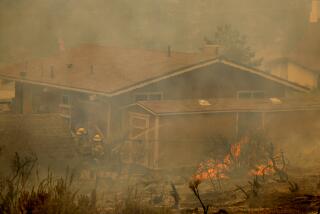Officials Praise Plan to Increase Logging in Sierra
SONORA — Saying the 11.5 million acres of national forests in the Sierra Nevada are dangerously overloaded with flammable material, a series of federal, state and local officials on Friday praised a proposal to significantly increase logging in the Sierra’s old-growth forests.
The proposal for changes in what is known as the Sierra Nevada Framework were presented Friday to more than 200 people crowded into an exhibit hall at the Sonora Fairgrounds. The forum’s speakers clearly supported the proposal, but the presence of representatives from a handful of conservation groups made for a few provocative exchanges.
The presenters included Mark Rey, undersecretary for natural resources at the U.S. Department of Agriculture. Rey sharply criticized lawsuits, which he said have postponed forest-thinning projects, and called such judicial reviews “insane.”
Another speaker, Thomas M. Bonnicksen, a professor of forest science at Texas A & M University, ridiculed the conservation community’s interest in old-growth trees, calling that focus a “trend” and “a fashion statement.”
This was the final public meeting before the plan’s comment period ends Sept. 12. If the framework is amended as expected, the changes could be implemented by this fall.
The revised Sierra plan would allow three times as much logging as currently permitted and would permit removal of trees as much as 30 inches in diameter from the 11 federal forests in the Sierra Nevada system.
The U.S. Forest Service has argued that the changes would reduce fire danger, a particular concern for communities such as Sonora, poised at the forest’s edge. Officials said the proposal would save taxpayers’ money, create jobs and generate revenue in depressed rural areas.
Rep. George P. Radanovich (R-Mariposa) said he supports the plan but advocates cutting trees of even larger diameter.
“Keep pushing for the removal of the larger trees,” he told the audience. “Man’s intrusion in the forest in the proper way can be good for the environment.”
Regional Forester Jack Blackwell said the plan will allow timber companies to harvest large, commercially viable trees and use the proceeds, in part, to pay for the removal of small trees and brush that have little market value but are highly flammable.
Conservation groups attacked the plan as a blueprint for the wholesale logging of national forests that targets many of the largest, most fire-resistant trees, which provide shelter for wildlife.
“I’m not against logging,” said Jay Watson, regional coordinator for the Wilderness Society. “Logging was part of the original framework. But I would argue that it is the forest that draws people to this area, for recreation and other uses.”
Much of the day’s discussion centered on rural economics and the role of the state’s $14-billion-a-year timber industry. The Forest Service projects nearly 1,900 jobs will be created by the changes and $57 million in earnings will be generated over 10 years.
Phil Aune, of the California Forestry Assn., offered computer projections that the state’s timber industry would evaporate by 2009 without changes in current forest management policies.
The proposed revision is the latest in a series of changes to the Clinton-era plan, which made large areas of the Sierra off limits to logging to protect wildlife habitat. The old-growth forests are home to the California spotted owl, among other animals.
The tiny bird was the focal point of local residents’ ire over what they considered unnecessary restrictions on land use. During Friday’s forum, applause broke out when a speaker noted that the owl is not listed as an endangered species.
The revised Sierra plan would allow loggers to cut tree cover to reduce fire risk in areas where the owl nests and forages. If logging occurs in a designated owl habitat area, a compatible nearby area must be set aside for the owls.
The Forest Service’s analysis showed that, although the new plan would fragment and degrade owl habitat over the next 20 years, in the long run forest regrowth would sustain the birds. That conclusion has been challenged by several biologists and owl experts.
Rey, who oversees the U.S. Forest Service, came to the administration after nearly two decades in the timber industry and was most recently vice president of the American Forest and Paper Assn.
More to Read
Sign up for Essential California
The most important California stories and recommendations in your inbox every morning.
You may occasionally receive promotional content from the Los Angeles Times.











